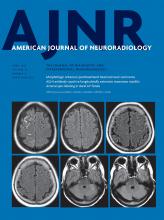Index by author
Choi, Y.S.
- FELLOWS' JOURNAL CLUBAdult BrainOpen AccessWhole-Tumor Histogram and Texture Analyses of DTI for Evaluation of IDH1-Mutation and 1p/19q-Codeletion Status in World Health Organization Grade II GliomasY.W. Park, K. Han, S.S. Ahn, Y.S. Choi, J.H. Chang, S.H. Kim, S.-G. Kang, E.H. Kim and S.-K. LeeAmerican Journal of Neuroradiology April 2018, 39 (4) 693-698; DOI: https://doi.org/10.3174/ajnr.A5569
Ninety-three patients with World Health Organization grade II gliomas with known IDH-mutation and 1p/19q-codeletion status (18 IDH1 wild-type, 45 IDH1-mutant and no 1p/19q codeletion, 30 IDH-mutant and 1p/19q codeleted tumors) underwent DTI. ROIs were drawn on every section of the T2-weighted images and transferred to the ADC and the fractional anisotropy maps to derive volume-based data of the entire tumor. Histogram and texture analyses were correlated with the IDH1-mutation and 1p/19q-codeletion status. Various histogram and texture parameters differed significantly according to IDH1-mutation and 1p/19q-codeletion status. The skewness and energy of ADC, fractional anisotropy 10th and 25th percentiles, and correlation of fractional anisotropy were independent predictors of an IDH1 wild-type in the least absolute shrinkage and selection operator. The authors conclude that whole-tumor histogram and texture features of the ADC and fractional anisotropy maps are useful for predicting the IDH1-mutation and 1p/19q-codeletion status in World Health Organization grade II gliomas.
Clark, T.J.
- Head and Neck ImagingYou have accessClinical Validation of a Predictive Model for the Presence of Cervical Lymph Node Metastasis in Papillary Thyroid CancerN.U. Patel, K.E. Lind, K. McKinney, T.J. Clark, S.S. Pokharel, J.M. Meier, E.R. Stamm, K. Garg and B. HaugenAmerican Journal of Neuroradiology April 2018, 39 (4) 756-761; DOI: https://doi.org/10.3174/ajnr.A5554
Delattre, B.M.A.
- Spine Imaging and Spine Image-Guided InterventionsYou have accessNormal Values of Magnetic Relaxation Parameters of Spine Components with the Synthetic MRI SequenceM. Drake-Pérez, B.M.A. Delattre, J. Boto, A. Fitsiori, K.-O. Lovblad, S. Boudabbous and M.I. VargasAmerican Journal of Neuroradiology April 2018, 39 (4) 788-795; DOI: https://doi.org/10.3174/ajnr.A5566
De Perrot, T.
- FELLOWS' JOURNAL CLUBHead and Neck ImagingYou have accessMRI with DWI for the Detection of Posttreatment Head and Neck Squamous Cell Carcinoma: Why Morphologic MRI Criteria MatterA. Ailianou, P. Mundada, T. De Perrot, M. Pusztaszieri, P.-A. Poletti and M. BeckerAmerican Journal of Neuroradiology April 2018, 39 (4) 748-755; DOI: https://doi.org/10.3174/ajnr.A5548
The authors analyzed 1.5T MRI examinations of 100 consecutive patients treated with radiation therapy with or without additional surgery for head and neck squamous cell carcinoma. MRI examinations included morphologic sequences and DWI. Histology and follow-up served as the standard of reference. Two readers, blinded to clinical/histologic/ follow-up data, evaluated images according to clearly defined criteria for the diagnosis of recurrent head and neck squamous cell carcinoma/second primary head and neck squamous cell carcinoma occurring after treatment, post-radiation therapy inflammatory edema, and late fibrosis. They conclude that adding precise morphologic MRI criteria to quantitative DWI enables reproducible and accurate detection of recurrent head and neck squamous cell carcinoma/second primary head and neck squamous cell carcinoma occurring after treatment.
De Seta, D.
- Head and Neck ImagingYou have accessIntraoperative Conebeam CT for Assessment of Intracochlear Positioning of Electrode Arrays in Adult Recipients of Cochlear ImplantsH. Jia, R. Torres, Y. Nguyen, D. De Seta, E. Ferrary, H. Wu, O. Sterkers, D. Bernardeschi and I. MosnierAmerican Journal of Neuroradiology April 2018, 39 (4) 768-774; DOI: https://doi.org/10.3174/ajnr.A5567
Devulapalli, K.K.
- Adult BrainYou have accessUtility of Repeat Head CT in Patients with Blunt Traumatic Brain Injury Presenting with Small Isolated Falcine or Tentorial Subdural HematomasK.K. Devulapalli, J.F. Talbott, J. Narvid, A. Gean, B. Rehani, G. Manley, A. Uzelac, E. Yuh and M.C. HuangAmerican Journal of Neuroradiology April 2018, 39 (4) 654-657; DOI: https://doi.org/10.3174/ajnr.A5557
Drake-perez, M.
- Spine Imaging and Spine Image-Guided InterventionsYou have accessNormal Values of Magnetic Relaxation Parameters of Spine Components with the Synthetic MRI SequenceM. Drake-Pérez, B.M.A. Delattre, J. Boto, A. Fitsiori, K.-O. Lovblad, S. Boudabbous and M.I. VargasAmerican Journal of Neuroradiology April 2018, 39 (4) 788-795; DOI: https://doi.org/10.3174/ajnr.A5566
Dreizin, D.
- Adult BrainYou have accessDual-Energy CT in Hemorrhagic Progression of Cerebral Contusion: Overestimation of Hematoma Volumes on Standard 120-kV Images and Rectification with Virtual High-Energy Monochromatic Images after Contrast-Enhanced Whole-Body ImagingU.K. Bodanapally, K. Shanmuganathan, G. Issa, D. Dreizin, G. Li, K. Sudini and T.R. FleiterAmerican Journal of Neuroradiology April 2018, 39 (4) 658-662; DOI: https://doi.org/10.3174/ajnr.A5558
Duhamel, G.
- EDITOR'S CHOICEAdult BrainOpen AccessEvaluation of the Sensitivity of Inhomogeneous Magnetization Transfer (ihMT) MRI for Multiple SclerosisE. Van Obberghen, S. Mchinda, A. le Troter, V.H. Prevost, P. Viout, M. Guye, G. Varma, D.C. Alsop, J.-P. Ranjeva, J. Pelletier, O. Girard and G. DuhamelAmerican Journal of Neuroradiology April 2018, 39 (4) 634-641; DOI: https://doi.org/10.3174/ajnr.A5563
Twenty-five patients with relapsing-remitting MS and 20 healthy volunteers were enrolled in a prospective study with a protocol including anatomic imaging, standard magnetization transfer, and inhomogeneous magnetization transfer imaging. Magnetization transfer and inhomogeneous magnetization transfer ratios measured in normal-appearing brain tissue and in MS lesions of patients were compared with values measured in controls. The magnetization transfer ratio and inhomogeneous magnetization transfer ratio measured in the thalami and frontal, occipital, and temporal WM of patients with MS were lower compared with those of controls. The sensitivity of the inhomogeneous magnetization transfer technique for MS was highlighted by the reduction in the inhomogeneous magnetization transfer ratio in MS lesions and in normal-appearing WM of patients compared with controls.
Dworkin, J.D.
- Adult BrainOpen AccessAn Automated Statistical Technique for Counting Distinct Multiple Sclerosis LesionsJ.D. Dworkin, K.A. Linn, I. Oguz, G.M. Fleishman, R. Bakshi, G. Nair, P.A. Calabresi, R.G. Henry, J. Oh, N. Papinutto, D. Pelletier, W. Rooney, W. Stern, N.L. Sicotte, D.S. Reich and R.T. Shinohara the North American Imaging in Multiple Sclerosis CooperativeAmerican Journal of Neuroradiology April 2018, 39 (4) 626-633; DOI: https://doi.org/10.3174/ajnr.A5556








